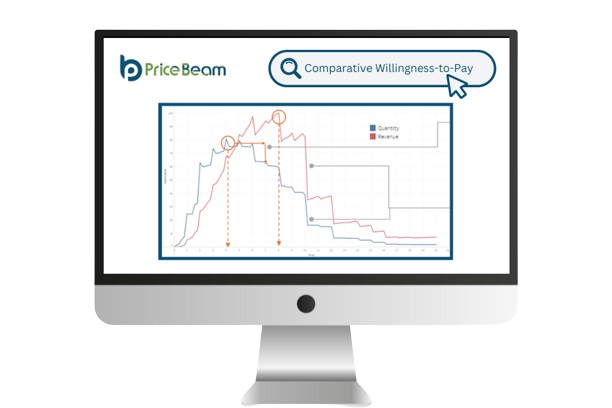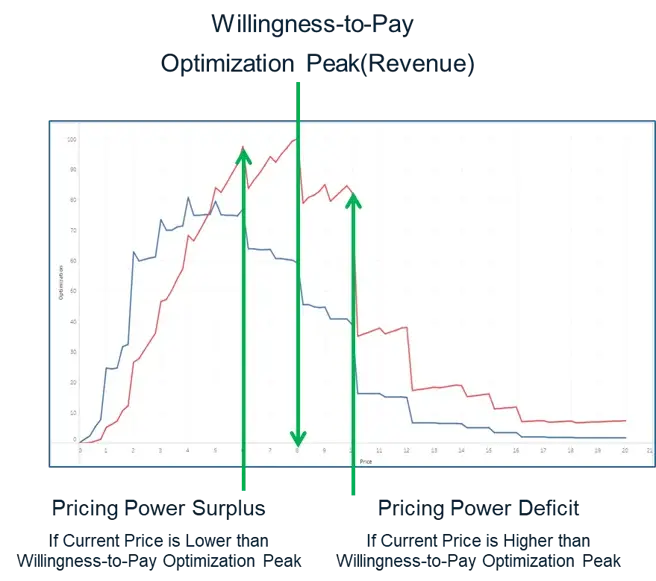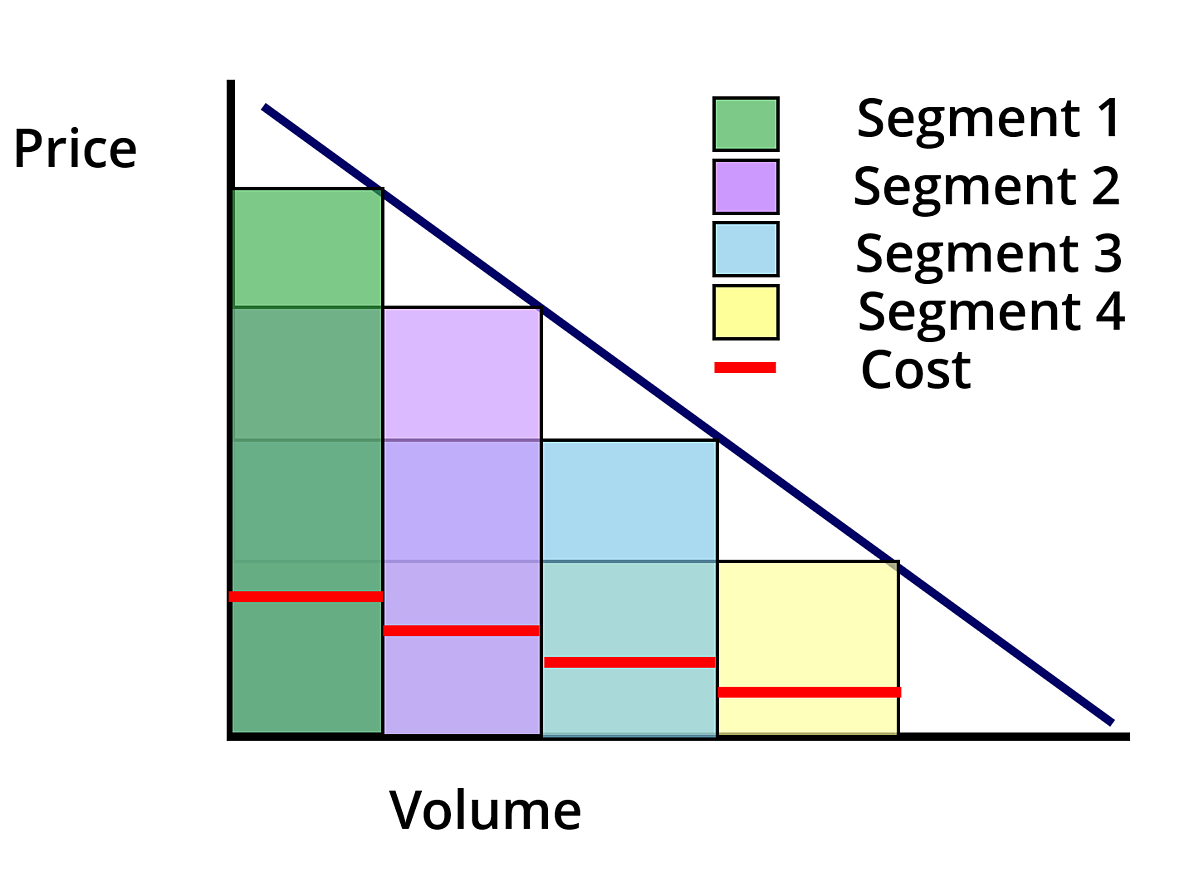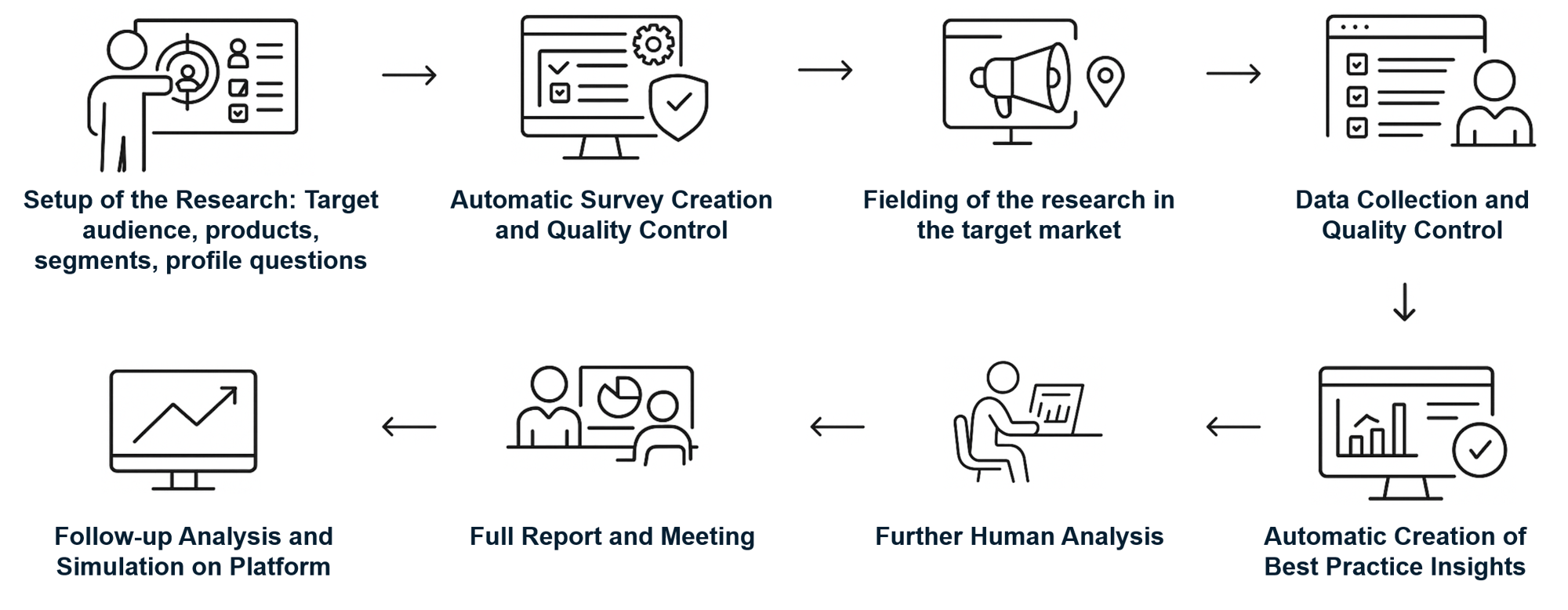Comparative Willingness-to-Pay
A Comparative Willingness-to-Pay (CWtP) study reveals what customers are prepared to pay for your products or those of your competitors. Easy to launch and run, this approach delivers virtual demand curves that identify optimal pricing for maximizing units sold, revenue, and margin.
PriceBeam Comparative Willingness-to-Pay is a core predictive research offering within the PriceBeam RGM360 Solution.

Advantages and Benefits
A Comparative Willingness-to-Pay study provides clear, reliable insights into how consumers perceive value and what they are willing to pay. PriceBeam Comparative WtP delivers fast results, typically within one to three weeks depending on project scope, and uncovers detailed metrics, including willingness-to-pay at each price point, optimal pricing, price elasticity, psychological price thresholds, and benchmarks across segments, your own product portfolio, and competitors.
CWtP stands out for its omni-channel and consumer-centric approach. It captures insights from all sales channels, not just those with point-of-sale data, giving you a true understanding of customers, shoppers, and consumers across the entire market. This comprehensive view makes PriceBeam Comparative Willingness-to-Pay especially effective for both optimizing prices for current products and determining pricing for new product innovations.
Challenges Solved by a PriceBeam Comparative Willingness-to-Pay Study
Comparative Willingness-to-Pay studies deliver rapid, data-driven insight into price perception and value across your portfolio, enabling you to make informed pricing decisions with confidence. Whether you are benchmarking against your own products, analyzing competitors, evaluating private labels, or exploring pricing strategies for new innovations, these studies provide precise forecasts of what your customers or target audience are prepared to pay. By pinpointing optimal price points for different market segments, you can enhance revenue, improve profit margins, and de-risk your pricing strategy, supporting successful launches and maximizing long-term growth.
What are Customers Willing to Pay?
Eighty-eight percent of prices are determined by intuition or incremental adjustments, rather than true market insights. Many pricing decisions overlook what customers are actually willing to pay. For example, if the production cost is $2, setting a price at $4 may seem reasonable, but it misses additional value if customers are in fact willing to pay $6.
There are significant differences in willingness-to-pay within most product categories, whether in B2B or B2C markets. In consumer goods, the top 20% of consumers are willing to pay up to 3.5 times more than the bottom 20% within the same category.
Understanding willingness-to-pay is critical for determining the right price points. PriceBeam Comparative Willingness-to-Pay measures willingness-to-pay across a range of price points and transforms these findings into clear, actionable insights for your business.

.png)
Price Increases Done Right
Willingness-to-Pay insights allow you to optimize price increases with precision. If your current price is below your customers’ maximum willingness to pay, a price increase is likely to face minimal resistance, as customers continue to perceive strong value. However, if the current price matches or exceeds their highest willingness to pay, increasing the price further can lead to pushback, as customers may view the product as overpriced.
Leverage Willingness-to-Pay data to plan future price adjustments with confidence. Analyze willingness-to-pay by customer segment to uncover opportunities such as by channel, demographic, purchase occasion, or other key factors where higher pricing is feasible. This targeted approach helps you identify where price increases can be successfully implemented while maintaining customer satisfaction.
Pricing Innovation Right
Setting prices for new products or services is challenging. Around 85% of new innovations fail, often because pricing does not match what the market is willing to pay.
Willingness-to-Pay insights help you identify price points that truly connect with your customers. You can segment these insights to see which customer groups are willing to pay more and which are sensitive to price.
Timing is also critical. Gather Willingness-to-Pay insights early in the innovation process to guide both product development and pricing strategy. This approach helps you avoid costly investments in products that do not deliver perceived value or align with what customers are ready to pay.
.png?width=1200&height=800&name=WtP%20concept%20%20(1).png)
.png)
Benchmarking: Own Products, Packs, Occasions, and Competitors
Identifying differences in Willingness-to-Pay between your products and those of competitors can unlock substantial profit opportunities. If customers are willing to pay 20% more for your product compared to a competitor or private label, that is a pricing advantage you can confidently pursue. However, if consumers see both products as offering equal value, setting a higher price may risk losing market share.
You can also compare Willingness-to-Pay across different pack formats, product sizes, and consumption occasions to refine your Price Pack Architecture. By analyzing how customer value perception shifts between single units, multi-packs, or family-sized offerings, as well as daytime versus evening use, you can identify where pricing opportunities exist. These insights allow you to align pricing and product strategy with actual consumer demand, optimize your portfolio, and capture untapped value, ensuring every product configuration is both competitive and profitable.
Segmentation and Value Differentiation
Not all consumers are willing to pay the same price. In many consumer goods categories, the top 20% of buyers are willing to pay more than three times what the bottom 20% are willing to pay.
To effectively manage revenue growth, it's crucial to segment based on willingness-to-pay. This involves analyzing WtP insights by demographics, attitudes, channels, brands, flavors, packaging, retailers, and occasions.


Omni-channel and Consumer Centric
PriceBeam empowers you to make confident pricing decisions by delivering actionable insights into true consumer and customer sentiment. Leveraging advanced survey methodology and industry-leading test techniques, PriceBeam captures real-time perceptions and preferences from your target market across every sales channel, including those without point-of-sale data.
This comprehensive, consumer-centric approach ensures your pricing strategies are rooted in authentic, current market opinions, enabling you to respond to shifting demand patterns and competitive dynamics with precision and agility. With PriceBeam, your pricing decisions are always informed by the voice of the consumer, ensuring relevance and success across all channels.
Who is a Comparative WtP Study for?
RGM Teams:
Revenue Growth Management teams will benefit from using a Comparative WtP study to help with pricing strategy, price pack architecture, price planning and execution.
Insight Teams:
The insights team benefits from a CWtP study as it makes it easier to run pricing insights and provides the organization with detailed robust reporting.
Innovation Teams:
A CWtP study will help innovation teams with the development of products and understand how consumers will react to any new product development or concept.
Industries that benefit from a Comparative WtP Study
FMCGs/CPG
Beverages
Apparel
Cosmetics
Home Care
Food
Pet Food
Consumer Electronics
Veterinary Products
How the Research Works

Frequently Asked Questions
How can you measure what customers are willing to pay for my product or service?
There are well established methods to do so that have been used for decades, and helped tens of thousands, if not millions of products and services to be priced right. PriceBeam have enhanced some of these methods to become more accurate and more practical to use.
How do you deliver the results?
You will have online access to detailed analyses that include both our specific pricing advice and the answer to the other questions the research included. If you have elected to purchase the Advanced plan, this also include human interpretation of the data. Results can also be exported to PDF.
If I have a number of product or service to test, do you offer volume discount?
Yes, please contact us to discuss.
What are the costs?
Please contact us to get a proposal tailored to your needs.
In what countries can I get research?
Albania
Algeria
Angola
Argentina
Australia
Austria
Azerbaijan
Bahrain
Bangladesh
Belarus (currently not accepting projects for this country)
Belgium
Bolivia
Bosnia and Herzegovina
Botswana
Brazil
Brunei
Bulgaria
Cambodia
Cameroon
Canada
Chile
China
Colombia
Congo D.R.
Costa Rica
Côte d'Ivoire
Croatia
Czech Republic
Cyprus
Denmark
Dominican Republic
Ecuador
Egypt
El Salvador
Estonia
Ethiopia
Finland
France
Gabon
Gambia
Germany
Ghana
Greece
Guatemala
Honduras
Hong Kong
Hungary
Iceland
India
Indonesia
Ireland
Israel
Italy
Japan
Jordan
Kazakhstan
Kenya
Kosovo
Kuwait
Laos
Latvia
Lebanon
Lesotho
Liberia
Lithuania
Luxembourg
Macau
Macedonia
Malaysia
Malta
Mauritius
Mexico
Moldova
Montenegro
Morocco
Mozambique
Myanmar
Namibia
Netherlands
New Zealand
Nicaragua
Nigeria
Norway
Oman
Pakistan
Panama
Paraguay
Peru
Philippines
Poland
Portugal
Puerto Rico
Qatar
Romania
Russia (currently not accepting projects for this country)
Rwanda
Saudi Arabia
Senegal
Serbia
Seychelles
Sierra Leone
Singapore
Slovakia
Slovenia
South Africa
South Korea
Spain
Sri Lanka
Sudan
Swaziland
Sweden
Switzerland
Taiwan
Tanzania
Thailand
Tunisia
Turkey
Uganda
Ukraine (currently not accepting projects for this country)
United Arab Emirates
United Kingdom
Uruguay
USA
Venezuela
Vietnam
Zambia
Zimbabwe
Can I include competitor brands in my analysis?
Yes, you are able in include competitors’ products within the CWtP study.
Is there an ideal number of products to test?
PriceBeam’s CWtP study can accommodate anywhere between 2 and 96 products. Whilst there is no “ideal” number, you should be wary of respondent fatigue.
What methodologies do you use?
Based on the best parts from Machine Learning, PSM, Gabor-Granger, Newton-Miller-Smith with elements from choice-based conjoint analysis.
Resources
%20(1).png)
Let's get you started
Book a demo with one of our PriceBeam experts and discover our platform capabilities.
.png?width=800&height=800&name=Read%20the%20story%20(600%20x%20600%20px).png)
Case studies
Learn how our customers were able to solve their pricing challenges and increase revenue.
%20(1).png)
PriceBeam Webinars
Catch up on all our webinars from topics on AI, RGM, Promotional Pricing, Market Simulation, and much more.
.png?width=400&height=100&name=PBLogoTransparent%20(1).png)
